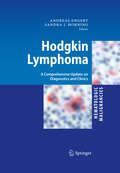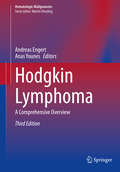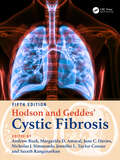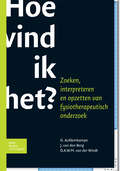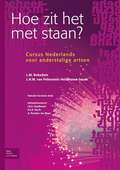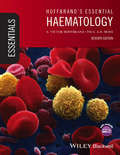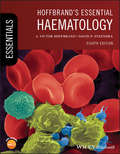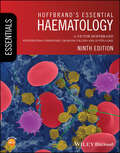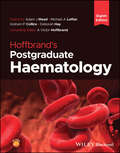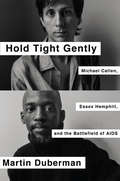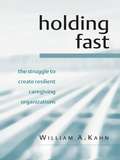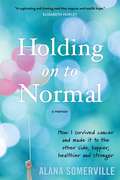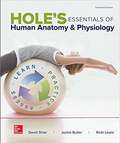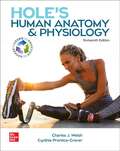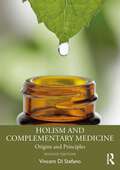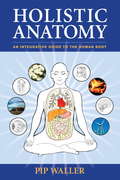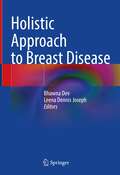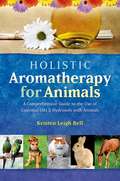- Table View
- List View
Hodgkin Lymphoma
by Anas Younes Andreas EngertThis book examines in detail the current treatment options for first-line, relapsed, and refractory Hodgkin lymphoma and the management appropriate in special clinical circumstances, including in the elderly, pregnant women, and those with lymphocyte-predominant disease. Careful attention is devoted to the emerging individually tailored treatment strategies that are especially appealing given their potential to reduce early and late treatment side effects in this generally young patient population. In addition, clear guidance is provided on the management of Hodgkin survivors. Other topics addressed include epidemiology, pathogenesis, the role of the microenvironment, initial clinical evaluation, imaging diagnosis, use of staging systems, and prognostic factors. The second edition of Hodgkin Lymphoma: A Comprehensive Overview has been revised and updated by the key opinion leaders to reflect recent progress in the field. It will be of great value to hematologists, oncologists, and all others with an interest in Hodgkin lymphoma.
Hodgkin Lymphoma
by Andreas Engert Sandra J. HorningThis book provides a well-illustrated, comprehensive, and up-to-date account of Hodgkin lymphoma. Epidemiology, pathogenesis, and the role of the microenvironment are examined in detail. The initial clinical evaluation and use of staging systems are fully discussed, and prognostic factors are carefully considered. The various treatment options for first-line and relapsed Hodgkin lymphoma are presented, including the newly available treatments for recurrent disease and the management required in special clinical circumstances. Given the very high cure rates and the young age of many patients, there is an increasing need to develop better individually tailored treatment strategies that will help to avoid both early and late side-effects of treatment. Such strategies receive due attention, and clear guidance is provided on the handling of Hodgkin survivors. This book will be of great value to hematologists, oncologists, and all others with an interest in Hodgkin lymphoma.
Hodgkin Lymphoma: A Comprehensive Overview (Hematologic Malignancies)
by Anas Younes Andreas EngertThis book, now in its third edition, examines the current treatment options for first-line, relapsed, and refractory Hodgkin lymphoma and the appropriate management in special clinical circumstances, including in the elderly, pregnant women, and those with nodular lymphocyte-predominant disease (NLPHL). Careful attention is devoted to the emerging individually tailored treatment strategies, including checkpoint inhibition, that are especially appealing given their potential to reduce early and late treatment side effects in this generally young patient population. In addition, clear guidance is provided on the management of Hodgkin survivors. Other topics addressed include epidemiology, pathogenesis, the role of the microenvironment, initial clinical evaluation, imaging diagnosis, use of staging systems, and prognostic factors. The new edition of Hodgkin Lymphoma: A Comprehensive Overview has been revised and updated by key opinion leaders to reflect recent progress in the field. It will be of great value to hematologists, oncologists, and all others with an interest in Hodgkin lymphoma.
Hodson and Geddes' Cystic Fibrosis
by Andrew Bush Amaral PHD, Margarida D. Davies MBCHB, MRCP, FRCPCH, MD, FERS, Jane C. Nicholas J. J. Simmonds Bmedsci Hons Bm Bs Taylor-Cousar, Jennifer L. Sarath RanganathanCystic Fibrosis has seen dramatic advances in treatment since the last edition, including targeted cystic fibrosis transmembrane conductance regulator (CFTR) protein modulators for most CFTR gene abnormalities. This new fifth edition is an update and expansion of the rapid clinical and scientific advances in improving prognosis, and the impact of COVID-19, all of which has transformed conventional models of care. It covers basic science, such as how detailed understanding of the biology of the CFTR gene and protein has led to novel and beneficial therapies, as well as all aspects of clinical management in high-, middle- and low-income settings and the voices of individuals with CF from across the world. It will be a useful reference for clinicians, including all levels of trainees, across the whole multidisciplinary team, scientists and students. Key Features • Follows an appealing organization of chapters, by developing fundamental knowledge of the reader before moving on to more complex or developing topics.• Presents a comprehensive, authoritative and up-to-date text, integrating fundamental science and clinical aspects of cystic fibrosis providing an attractive read for clinicians, trainee doctors and scientists.• Draws on global expertise and reflects best evidence-based practice from experts conducting cutting-edge clinical and basic science research from around the world.
Hoe krijgen we onze zorg passend?: Tijd voor een nieuwe kijk op gezondheid en ziekte
by Tijn KoolDe zorg loopt vast. Het personeelstekort loopt op en we vragen steeds vaker om zorg. Tegelijkertijd weten we van veel behandelingen niet of deze werken. We leveren zelfs zorg waarvan we weten dat deze niet werkt of – in het ergste geval – schade veroorzaakt. Bovendien levert de zorg een grote bijdrage aan de CO2-uitstoot. Reden voor Tijn Kool, hoogleraar Passende Zorg aan het Radboudumc, om te pleiten voor een andere kijk op gezondheid en ziekte. Volgens Kool moet de zorgverlener meer dan voorheen een coach gaan zijn die patiënten helpt bij het maken van een keuze. En die keuze wordt vaker ‘niets-doen’. Want de meeste klachten gaan vanzelf over. Sterker nog, behandelen kan averechts werken. Terughoudend zijn is daarom belangrijk, bij artsen en bij patiënten. En het besef dat niet de zorg maar het individuele gedrag van mensen en hun sociale context bepalend zijn voor gezondheid. Veel meer aandacht dus voor leefstijl, maat schappelijke participatie, zingeving en betrouwbare patiëntinformatie. En een actieve overheid die haar burgers helpt bij de zoektocht naar een gezond leven. Dit boek is het resultaat van onderzoek van Tijn Kool en dat van veel van zijn collega’s. Hij heeft voor zijn oratie dankbaar gebruik kunnen maken van hun zinvolle resultaten over effectiviteit van zorg, obesitas, sociaal-economische gezondheidsverschillen en nog vele andere onderwerpen. Om de resultaten breed toegankelijk te maken schreef hij een publieksversie van zijn oratie. Tijn Kool is hoogleraar Passende Zorg aan de Radboud Universiteit/ Radboudumc. Hij is als arts en econoom al 35 jaar bevlogen bezig met implementeren van passende zorg en deïmplementeren van niet-passende zorg.
Hoe maak ik een CAT: Handleiding voor de verpleegkunde
by Kim Donachie Leslie Michielsen Mirjam PetersDit boek beschrijft stap voor stap hoe je een Critical Appraisal of a Topic (CAT) naar een verpleegkundig onderwerp uitvoert, op een leuke, eenvoudige manier, die niet veel tijd kost. Het boek helpt bovendien om de resultaten te koppelen aan de verpleegkundige praktijk. Het is daarmee essentieel voor alle (toekomstige) verpleegkundigen, verpleegkundig specialisten en verplegingswetenschappers die de verpleegkundige zorg willen laten aansluiten op evidence-based practice.Hoe maak ik een CAT. Handleiding voor de verpleegkunde geeft géén theoretische beschouwing van wetenschappelijk onderzoek en EBP, maar biedt juist praktische handvatten voor het uitvoeren van een kort literatuuronderzoek (CAT). Het neemt je aan de hand van praktische tips en voorbeelden mee in alle stappen van het CAT-proces. Bovendien geeft Hoe maak ik een CAT je adviezen over het vertalen van een praktijkvraag naar een beantwoordbare onderzoeksvraag en over het systematisch zoeken, vinden, selecteren en beoordelen van wetenschappelijke artikelen. Je leert hoe je resultaten van je CAT kunt vertalen naar praktische aanbevelingen. Vervolgens geeft deze handleiding je handvatten bij het implementeren van een verandering in de praktijk. Auteurs van het boek zijn Kim Donachie, Leslie Michielsen en Mirjam Peters. Ze werken alle drie als docent verpleegkunde aan de Hogeschool van Arnhem en Nijmegen.
Hoe vind ik het?
by G. Aufdemkampe D.A.W.M. VAN DER Windt J. van den BergWaar kan ik relevante wetenschappelijke informatie vinden en hoe moet ik deze bevindingen beoordelen op hun relevantie?Hoe vind ik het? biedt fysiotherapeuten (in opleiding) een eerste kennismaking met het zoeken en interpreteren van vakliteratuur, met name toegespitst op onderzoekesliteratuur.Veel aandacht wordt hierbij besteed aan het internet als informatiebron. Daarnaast wordt het opzetten en uitvoeren van onderzoek gedegen behandeld.De auteurs hebben zich gericht op een zo praktisch mogelijke weergave van de materie en gevem waar ,mogelijk relevante websites aan. Aan de hand van talrijke praktijkvoorbeelden zijn verschillende soorten onderzoek uitgewerkt. Elk hoofdstuk wordt voorafgegaan door doelstellingen en afgesloten met of meerdere opdrachten, wat het boek zeer geschikt maakt voor zelfstudie.De auteurs hebben zich gericht op een zo praktisch mogelijke weergave van de materie en gevem waar ,mogelijk relevante websites aan. Aan de hand van talrijke praktijkvoorbeelden zijn verschillende soorten onderzoek uitgewerkt. Elk hoofdstuk wordt voorafgegaan door doelstellingen en afgesloten met of meerdere opdrachten, wat het boek zeer geschikt maakt voor zelfstudie.De vele veranderingen rondom internet maakten deze herziening noodzakelijk. Bovendien is een hoofdstuk over cohortonderzoek toegevoegd en is een compleet nieuwe bijlage opgenomen met een samenvatting over het zoeken naar informatie op PubMed.
Hoe zit het met staan?: Cursus Nederlands voor anderstalige artsen
by L.M. Bekedam L.H.M. Palenstein Helderman-SusanHet beheersingsniveau van het Nederlands laat bij veel anderstalige instromers te wensen over, ook al is het staatsexamen behaald. Een arts functioneert alleen goed met voldoende kennis van Nederlandse equivalenten van medische termen, een goed begrip van wat een patiënt vertelt en het vermogen grammaticaal correcte zinnen te formuleren. Voor het ontwikkelen van deze taalvaardigheden is Hoe zit het met staan? een onmisbaar hulpmiddel.Alle negentien hoofdstukken beginnen met een gesprek tussen arts en patiënt. Deze gesprekken zijn opgenomen op cd–rom en gebaseerd op in de klinische praktijk gevoerde, realistische gesprekken. Het onderdeel Luisteren behandelt niet alleen het goed verstaan van woorden en begrippen, maar gaat ook in op het herkennen van de gemoedstoestand van de patiënt. Vocabulaire, Idioom en Grammatica komen in Hoe zit het met staan? uitgebreid aan de orde. In nagenoeg alle hoofdstukken wordt ook aandacht geschonken aan zaken die aanleiding kunnen geven tot misverstanden als gevolg van cultuurverschillen.
Hoffbrand's Essential Haematology
by Victor Hoffbrand Paul A. MossThe definitive haematology textbook of choice for medical studentsHoffbrand's Essential Haematology has built a reputation as the flagship haematology textbook for both students and junior doctors, providing an authoritative introduction to the subject.Now in its 7th edition, this classic text provides up-to-date knowledge of the pathogenesis, clinical and laboratory features, treatment of blood and bone marrow disorders, in its concise and user-friendly style.Hoffbrand's Essential Haematology outlines the basic principles of clinical and laboratory haematology and shows how manifestations of blood diseases can be explained by new knowledge of the disease processes. It is an indispensable resource for students and trainees and an essential read for all specialists who are interested in updating their knowledge.Hoffbrand's Essential Haematology:* Provides up-to-date knowledge of the pathogenesis, clinical and laboratory features and treatment of all blood disorders* Features detailed information on the new genetics of leukaemia and lymphoma* Includes a new chapter on thrombosis, focussing on the new oral anticoagulants* Is beautifully presented, with over 300 colour illustrations* Comprehensively covers both theory and treatment regimes* Includes a companion website at www.wileyessential.com/haematology featuring all the figures and tables from the book, and over 300 interactive multiple choice questions
Hoffbrand's Essential Haematology (Essentials)
by A. Victor Hoffbrand David P. SteensmaThe new and fully updated edition of the definitive haematology textbook for undergraduate and postgraduate students and trainees Hoffbrand's Essential Haematology is widely regarded as the most authoritative introduction to the subject available, helping medical students and trainee doctors understand the essential principles of modern clinical and laboratory haematology for nearly four decades. Now in its eighth edition, this market-leading textbook introduces the formation and function of blood cells and the diseases that arise from dysfunction and disruption of these processes. Beautifully presented with over 300 stunning colour illustrations, the new edition has been thoroughly updated to reflect recent advances in knowledge of the pathogenesis of blood diseases and their diagnosis and treatment. This new text: Describes disorders and diseases of the blood such as the various anaemias and white cell disorders, leukaemias, lymphomas and myeloma, as well as bleeding and thrombotic disorders Incorporates the latest World Health Organization (WHO) classification of haematological neoplastic diseases Reviews contemporary application of multiparameter flow cytometry, DNA sequencing and other technologies in evaluating patients with suspected haematological disease Discusses the therapeutic use of chimeric antigen T-cells, mono- and bi-specific monoclonal antibodies, inhibitors of intracellular signalling pathways and direct orally acting anticoagulants Includes sections on blood transfusion and the haematological aspects of systemic diseases, pregnancy and the neonate Hoffbrand's Essential Haematology is a vital resource for all students and trainees, and a valuable reference for practicing specialists wishing to update their knowledge.
Hoffbrand's Essential Haematology (Essentials)
by A. Victor HoffbrandHOFFBRAND’S ESSENTIAL HAEMATOLOGY The Essentials is an international, best-selling series of textbooks, all of which are designed to support lecture series or themes on core topics within the health sciences. See www.wiley.com for further details. The definitive introductory textbook on haematology, covering basic science, diagnostic testing, clinical features, and patient management Hoffbrand’s Essential Haematology has helped medical students and trainee physicians understand the core principles of clinical and laboratory haematology for more than four decades. Original contributions by leading experts provide authoritative coverage of clinical and laboratory features and management within haematology, including the haematological aspects of systemic diseases, pregnancy, and the neonate. Hundreds of high-quality colour images illustrate various anaemias and white cell disorders, leukaemias, lymphomas and myeloma, bleeding and thrombotic disorders, and other blood diseases. Now in its ninth edition, this classic textbook incorporates current knowledge of the pathogenesis of blood diseases, the 5th WHO (2022) classification of haematological neoplasms, the detection of minimal residual disease, advances in the treatment of benign and neoplastic blood diseases. New sections focus on the haematological consequences of COVID-19 infection and vaccine -induced immune thrombotic thrombocy-topenia (VITT). Additional and expanded chapters describe non-Hodgkin lymphomas, amyloid, and haemophilia. Supported by a companion website with hundreds of MCQs and PowerPoint slides, Hoffbrand’s Essential Haematology, Ninth Edition, remains an indispensable resource for trainee haematologists and physicians.
Hoffbrand's Postgraduate Haematology
by A. Victor HoffbrandThe latest edition of the key haematology text Haematology, the study and treatment of blood and bone marrow disorders, is a rich and complex discipline that consistently produces cutting-edge medical research. Since 1972, Hoffbrand’s Postgraduate Haematology has acted as the foundational overview and reference text for this subject, introducing generations of trainees and medical residents to the pathogenesis, clinical and laboratory features, and management of blood disorders. The eighth edition of Hoffbrand’s Postgraduate Haematology, now with a new editorial team including leading clinicians and researchers, promises to continue this tradition of excellence with a fully updated text. Lavishly illustrated, comprehensive, and thoughtfully referenced, it is an indispensable resource. Readers of the eighth edition of Hoffbrand’s Postgraduate Haematology will also find: Four-color illustrations and photomicrographs of blood cells and tissues throughout to support key topicsNew sections analysing recent advances in next generation sequencing, genome editing, clonal haematopoiesis, anticoagulant drugs, diagnostic laboratory tools, and moreCompanion website with downloadable figures and other tools Hoffbrand’s Postgraduate Haematology is ideal for all postgraduate trainees or residents in haematology, as well as for clinicians and practitioners looking for a reference work on the subject and a guide to the latest research.
Hoffen und die Lust zu leben: Wie wir in der Ausrichtung auf Gesundheit und Glück Energie und Kraft finden
by Klaus-D. HüllemannIn diesem Buch lädt der Arzt und Psychotherapeut Professor Hüllemann ein, bei körperlichen, seelischen Krisen wie auch bei Alltagsfrust das Hoffen als Ressource zu entdecken und zu nutzen. Er wirbt dafür, den Affekt des Hoffens zu erleben – mit ihm, so zeigt der Autor, geht man aus sich heraus, macht sich weit, statt sich zu verengen. Bei Hoffnung denken viele zunächst an die Hoffnungslosigkeit – sie ist kaum auszuhalten, sie läuft den menschlichen Grundbedürfnissen zuwider, ist oft unerträglich. Und doch: Hoffnung ist das Lebensprinzip belasteter Menschen. Drei sich teilweise überlappende Hoffnungsfelder lassen sich beschreiben: (1) die Glückspielhoffnung, (2) die tapfere Hoffnung, (3) die sinngebende Hoffnung. Diese drei Felder unterscheiden sich und werden an Beispielen dargestellt. Auch diskutiert der Autor die Sinnfrage in Bezug auf Camus´ Sisyphos: Sisyphos ist ein glücklicher Mensch. Geschrieben für … … interessierte Laien. Psychotherapeuten, Ärzte und Berater können therapiebegleitend empfehlen. Der Autor: Prof. Dr. med. Klaus-Diethart Hüllemann, Facharzt für Innere Medizin, Psychosomatik Psychotherapie, Sportmedizin, Sozialmedizin, Rehabiliationswesen, langjähriger Ärztlicher Direktor, Initiator und Vorstand des Deutschen Netzes Gesundheitsfördernder Krankenhäuser und Gesundheitseinrichtungen g.e.V.. Er begegnete in seiner Tätigkeit bei WHO und Münchener Olympiade vielen namhaften Sportlern. Gründete die 1. Deutsche ambulante Herzsportgruppe im Deutschen Sportbund.
Hohes Alter in Deutschland (Schriften zu Gesundheit und Gesellschaft - Studies on Health and Society #8)
by Michael Wagner Clemens Tesch-Römer Julia Simonson Roman Kaspar Susanne ZankDies ist ein Open-Access-Buch.Trotz des schnellen Wachstums des Anteils der Bevölkerung in einem Alter ab 80 Jahren an der Gesamtbevölkerung ist das Wissen über diese Bevölkerungsgruppe bislang gering. Zwar gibt es thematisch, methodisch und regional spezifische Studien, jedoch keine repräsentative Erfassung der Lebenssituation und Lebensqualität dieser Altersgruppe für den gesamtdeutschen Raum. Eine gute Datenlage ist jedoch notwendig: Zum einen, um den besonderen Unterstützungsbedarfen im hohen Alter zukünftig besser gerecht werden zu können. Zum anderen, um Lösungsansätze für sozialpolitische Herausforderungen wie der sozialen Sicherung im Alter sowie im Hinblick auf eine Generationengerechtigkeit entwickeln zu können. Schließlich, um negativen Altersbildern und Vorurteilen über die Lebensqualität im hohen Alter empirisch fundiert entgegenwirken zu können. Die Studie "Hohes Alter in Deutschland“ (D80+) ist eine bundesweit repräsentative Querschnittsbefragung der hochaltrigen Menschen in Privathaushalten und in Heimen. Sie wird vom Bundesministerium für Familie, Senioren, Frauen und Jugend (BMFSFJ) gefördert und gemeinsam vom Cologne Center for Ethics, Rights, Economics, and Social Sciences of Health (ceres) und dem Deutschen Zentrum für Altersfragen (DZA) durchgeführt. Die Studie vereint Perspektiven der an den beteiligten Institutionen verorteten Disziplinen wie Soziologie, Psychologie, Versorgungswissenschaften, Gerontologie und Medizin. Im vorliegenden Band werden zentrale Befunde u.a. zu den Themenbereichen Soziale und Digitale Teilhabe, Gesundheit und Versorgung, sowie Werte und subjektives Wohlbefinden vorgestellt.
Hold Tight Gently: Michael Callen, Essex Hemphill, and the Battlefield of AIDS
by Martin DubermanIn December 1995, the FDA approved the release of protease inhibitors, the first effective treatment for AIDS. For countless people, the drug offered a reprieve from what had been a death sentence; for others, it was too late. In the United States alone, over 318,000 people had already died from AIDS-related complications-among them the singer Michael Callen and the poet Essex Hemphill.Meticulously researched and evocatively told, Hold Tight Gently is the celebrated historian Martin Duberman's poignant memorial to those lost to AIDS and to two of the great unsung heroes of the early years of the epidemic.Callen, a white gay Midwesterner who had moved to New York, became a leading figure in the movement to increase awareness of AIDS in the face of willful and homophobic denial under the Reagan administration; Hemphill, an African American gay man, contributed to the black gay and lesbian scene in Washington, D.C., with poetry of searing intensity and introspection.A profound exploration of the intersection of race, sexuality, class, identity, and the politics of AIDS activism beyond ACT UP, Hold Tight Gently captures both a generation struggling to cope with the deadly disease and the extraordinary refusal of two men to give in to despair.
Hold: A Medical Murder Mystery
by Amy S. PeeleSarah Golden and Jackie Larsen promised their partners they were out of the detective business. They declared “game over” after both of them almost lost their lives trying to solve their last medical mystery, and they’re happy with that decision: Sarah has finally allowed love and romance into her life, Jackie’s marriage is solid, and Jackie’s son, Wyatt, is still doing great with his year-old kidney transplant. So when they go on their dream trip to Cuba, they are not looking for trouble. But all their plans go out the window when a desperate plea from a Cuban transplant surgeon puts the duo in serious danger with the Cuban government on the same day the four most prominent immunologists in the world—doctors who were on the verge of solving the huge rejection issues that have plagued the transplant community for over fifty years—are killed in a car accident in Chicago. Soon, Sarah and Jackie find themselves dragged into the bowels of investigating venture capitalists and corporate greed—a terrain they know nothing about. As they uncover suspect clinical trials at major US transplant centers, including Sarah’s, their usual friends Biker Bob and Officer Handsome aren’t able to help them much, but they do receive assistance from an unlikely source: Sergio, who they helped to land in prison in Florida (and who is trying to win back his girlfriend), offers his help from the inside. Sarah and Jackie are armed with smarts, humor, and enough persistence to help them face the white-collared demons of corporate America—but with dangerous players gunning for them and death threats being made against their families, will they be able to solve this mystery before someone else gets hurt?
Holding Fast: The Struggle to Create Resilient Caregiving Organizations
by William A. KahnHow can caregivers remain both caring and strong enough to withstand the stress of their work?How can caregiving organizations effectively improve their management and practice?Increasing pressure on caregiving organizations to serve more people with fewer resources means that epidemics of burnout, high staff turnover, dissatisfaction and internal conflict often appear inevitable. Holding Fast focuses on the particular stress of caregiving work, its influences on the people and organizations who do that work, and what they can do about it. Illustrated by case studies based on extensive research in schools, hospitals, social work agencies, health care centres and religious institutions, Holding Fast identifies the problems faced by caregiving organizations, and outlines appropriate strategies for tackling these to create a resilient, effective organization. The book is divided into clear sections covering: * an introduction to the nature of caregiving organizations* the disturbances that can occur within them*the skills required to effectively lead them.Holding Fast offers a portrait of how organizations become, or are prevented from becoming, systems of caregiving. It will help leaders of caregiving organizations and their staff gain a better understanding of the difficulties encountered by their organizations, leading to improved management and practice.
Holding on to Normal: How I Survived Cancer and Made It to the Other Side, Happier, Healthier and Stronger
by Alana SomervilleA compelling memoir about trying to live meaningfully with illness and triumph beyond it, by breast cancer survivor Alana Somerville, a teacher and mother of two young children.I looked at all the sick people around me. Was I going to be like them? Was that already me? Did I suddenly have a time stamp on my life? Would I make it out of this alive? Alana Somerville—wife, teacher and mother of two small children—was thirty-three years old when she was diagnosed with stage-two, triple-negative breast cancer. The diagnosis changed her world and the relationships she had with everyone around her. Suddenly she was faced with endless medical appointments, multiple surgeries and procedures, the challenges of chemotherapy, and all the decisions involved in her treatment. She also had to deal with the trauma of realizing that her support network—sometimes even her closest friends—could struggle with how to help or even how to react to her anymore. Throughout the course of her illness, Alana learned to maneuver through the medical system, to advocate for herself, and to build a truly supportive network. She also discovered how to keep her positive spirit intact while undergoing a double mastectomy and ongoing treatment. She is now living cancer-free—a survivor and an advocate. Alana’s story is not unique. It’s a story that will resonate with anyone who has suffered illness and found themselves navigating a whole new world upon diagnosis. This is an “everywoman’s” journey through the experience of cancer, tracing the emotional, physical and psychological steps that are common to all. In the end, this memoir will offer hope that one can live a healthy, fulfilling and happy life beyond diagnosis. Holding on to Normal is for anyone who is suffering—or knows someone who is suffering from—a setback in life, and who is looking for inspiration on how to navigate their own journey.
Hole's Essentials of Human Anatomy and Physiology
by Ricki Lewis David Shier Jackie ButlerDesigned for the one-semester anatomy and physiology course, Hole's Essentials of Human Anatomy and Physiology assumes no prior science knowledge and supports core topics with clinical applications, making difficult concepts relevant to students pursuing careers in the allied health field. The learn, practice, and access system is used throughout the textbook and digital. "Learning" Outcomes at the beginning of each chapter set the stage for what students will learn, "Practice" questions at the end of each major section help check their recall on what they just read, and "Assess" end of chapter resources help students confirm their accurate recall of what they just learned and practiced. The learn, practice, and assess system is highly effective in providing students with a solid understanding of the important concepts in anatomy and physiology.
Hole's Human Anatomy and Physiology
by Charles J. Welsh Cynthia Prentice-CraverPerfect for introductory level students, Hole's Human Anatomy and Physiology assumes no prior science knowledge by focusing on the fundamentals. <p><p>This new edition updates a great A&P classic, while offering greater efficiencies to the user including the tried and true Learn, Practice, Assess method throughout the text. The 16th edition focuses on helping students master core themes in anatomy and physiology, which are distilled down into key concepts and underlying mechanisms. <p><p>A new author team who is active in the classroom brings career relevance and more concise language, while updated and enhanced figures provide clarity.
Hole's Human Anatomy and Physiology
by Ricki Lewis Jackie L. Butler David N. Shier Leslie Day Julie PilcherLearn. Practice. Assess. Hole's Human Anatomy and Physiology was created for the introductory level student and assumes no prior science knowledge by placing emphasis on the fundamentals. This new edition updates a great A&P classic while offering greater efficiencies to the user. The format for the 14th edition focuses on Learning Outcomes and Assessments to benefit the student along with the instructor.
Holism and Complementary Medicine: Origins and Principles
by Vincent Di StefanoThe rise of complementary medicine is one of the most important developments in healthcare over the past three decades. This popular text outlines the history and philosophy behind holistic therapies and examines their role in contemporary health systems. This fully updated new edition of Holism and Complementary Medicine offers a systematic overview of traditional healing practices, the development of the Western biomedical model from the ancient Egyptians and Greeks to the present, and the holistic philosophy which forms the basis of complementary and alternative medicine in the West. It includes a new chapter covering developments over the past two decades, including an increased focus on integrative medicine and public health. Additonal sections focus on new material related to traditional and indigenous medicines, including Ayurveda and Australian aboriginal medicine. The book explores the differences between holistic and conventional biomedical traditions and approaches, and acknowledging the strengths of each. It also addresses key practice issues, examining the role holistic principles have to play in today’s health system.Holism and Complementary Medicine is an accessible guide for students, practitioners, and anyone interested in the origins and core principles of natural therapies.
Holistic Anatomy
by Pip WallerComplementary and alternative approaches to health and medicine have become increasingly widespread as the limits of conventional treatments become more apparent. Holistic Anatomy presents an authoritative study of anatomy, physiology, and pathology but expands the discussion by connecting the science of the body to a variety of alternative modalities to explore how human beings exist within--and interact with--their environment, and how they experience existence in emotional and spiritual terms. Basic scientific terminology and detailed descriptions are interwoven with informal, sometimes humorous observations, facts, and ideas about life. The mechanisms, structure, and functions of the body are explored, along with how they relate to spiritual and energetic paradigms, emotions, and ecological principles. The first half of the book covers basic anatomy and physiology, describing each major system of the body and how they interrelate. This part includes a thoughtful discussion of aging and the dying process. The second half focuses on models of health and disease, both traditional and holistic. Topics include western pathology, emotional health, five element medicine, and the spiritual cause for disease.
Holistic Approach to Breast Disease
by Bhawna Dev Leena Dennis JosephThe book covers the entire gamut of breast diseases including all necessary dimensions, such as radiology, pathology, surgery and oncology. It provides a complete spectrum from clinical scenario, imaging investigations and interventions, final histopathological diagnosis and complete treatment plan from medical, surgical and radiation to follow up protocols. It discusses about common and uncommon varied breast diseases encompassing all necessary specialties. It includes stepwise pictorial descriptions of ‘must know’ in breast lesions. It presents high resolution images of the latest technologies in radiology and pathology based on typical case scenarios. The book features special chapters on recent updates and innovative technologies used in imaging, pathology and management of breast diseases. It contains line diagrams and flow charts for quick reading and easy understanding, to be practically implemented as and when required in any concerned specialties.The book is useful for consultants in radiology, pathology, general surgeons, onco-surgeons, super specialists and fellows in breast diseases, and postgraduates in these fields.
Holistic Aromatherapy for Animals
by Kristen Leigh BellThis resource provides effective aromatherapy information and treatments that improve and maintain animal health, as well as prevent common ailments in dogs, cats, and other animals.

